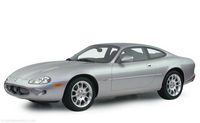New Car/Review
SEE ALSO: Jaguar Buyer's Guide
Jaguar XKR Coupe (2000)
By Matt/Bob Hagin
 Jaguar Full Line Video footage (9:21)
Jaguar Full Line Video footage (9:21)
SPECIFICATIONS
Manufacturer's Suggested Retail Price $75,800 (est.)
Price As Tested $77,395 (est.)
Engine Type w/SC* DOHC 32-valve 4.0 Liter V8 w/SMFI**
Engine Size 244 cid/3996 cc
Horsepower 370 @ 6150 RPM
Torque (lb-ft) 387 @ 3600 RPM
Wheelbase/Width/Length 101.9"/79.3"/187.4"
Transmission Five-speed automatic
Curb Weight 3828 pounds
Fuel Capacity 19.9 gallons
Tires (F/R) 245/45ZR18-front 255/45ZR18-rear
Brakes (F/R) Disc (ABS)/disc (ABS)
Drive Train Front-engine/rear-wheel-drive
Vehicle Type Four-passenger/two-door
Domestic Content N/A
Coefficient of Drag (Cd.) 0.34
PERFORMANCE
EPA Economy, miles per gallon
city/highway/average 16/23/20
0-60 MPH 5.5 seconds
1/4 (E.T.) 14.0 seconds @ 104.5 mph
Top speed (electronically limited) 155 mph
* Super charged
** Sequential multi-port fuel injection
(Bob Hagin worked on the original Jaguar XK sports cars at a shop in '51 when he graduated from high school. His son Matt can believe this, since his dad seems to have worked on almost every car ever made. He now wonders how long it will be before he pulls wrenches on the new XKR.)
BOB - Matt, the XK line from Jaguar has changed a lot since the first ones came out. The first was the 120 powered by a 3.4 liter in-line six cylinder engine that used twin-cams and sported a curvaceous body that still turns heads today. It made such a big impression on the public over the years that even during its darkest, financially- troubled days, the Jaguar name had a certain magic.
MATT - We're evaluating the top-of-the-line version this week. The XKR is above the slick XK8 that came out a few years ago. The XKR is almost indistinguishable from its "little" brother, with the only visible differences being a small spoiler on the trunklid, a three-piece wire mesh grille and some functional louvers on the hood. They both have a Ford-engineered 4.0 liter twin-cam V8 engine with 32-valves. I found it to be a bit low on power in the regular XK8. But 1200 lucky, well- heeled Jaguar enthusiasts will be able to buy an XKR which is, in effect, and XK8 with an extra power boost compliments of a supercharger.
BOB - As far as I can remember, this generation of Jags is the first to utilize a blower. The first was the XJR four-door that came out in '95 and used a six cylinder engine, then went over to the V8 that's now available on every car in the company's line. In the XKR, it pumps out 370 horsepower and 385 lb-ft of torque. With this much power it would be easy for a driver to get into trouble with law.
MATT - The huge 18-inch, aluminum rims are eye-catching and high performance Pirelli P-type tires are specially designed for the XKR. The tires and wheels are bigger in the back than the front and as a consequence, the spare is one of those embarrassing space-saver jobs. A five-speed automatic transmission is the only gearbox available and Ford outsources it from Mercedes-Benz. It's the same one that Mercedes uses in its SL500 and the reason is that Jaguar engineers felt that the unit used on the less-powerful XK8 wasn't strong enough for the extra torque the supercharged version puts out.
BOB - To keep the drivers from getting into trouble with so much power, Jaguar developed a Computer Active Technology Suspension system and gave it the acronym CATS. The system integrates engine power and anti-lock braking system (ABS) information along with the angle of the front wheels to keep the car from sliding sideways or plowing ahead in fast, tight turns. The Bilstein shocks are infinitely variable and their "tightness" is also controlled by the CATS computer system. On the road, these devices work in unison to compensate for road conditions and it all happens so fast, those inside aren't even aware of what's happening.
MATT - Ever since its earliest days, Jaguar has always gone for interiors that can only be described as "rich." The upholstery is done in leather in the typical British fashion and the seating is plush but surprisingly, the seats are not terribly well-bolstered on a car that was obviously built to be tossed around on picturesque back roads. But there's enough polished, burled wood on the interior to satisfy the most discerning customer. I found the round-faced instruments simple to use and read, but I'd rather see some sort of Italic numbers or letters used, just to make things more fancy. Another thing I didn't like was the gear-selector system. Its a "J" shaped shifter gate that lets the driver swing it over to the left, where three of the five forward gears can be selected. It feels too sloppy to be used as a sport-shift.
BOB - Even in its early days in the U.S. all Jaguars were plush and very stylish. Before you were born, your Mom and I had an early Mark VII sedan that was indeed very stylish, but it suffered from weak brakes.
MATT - I remember you telling me how the brakes failed in that car with my brothers and sisters inside. But Jaguar has come a long way since then, Dad, especially in the brake department so maybe now Mom will give the new versions a try.



